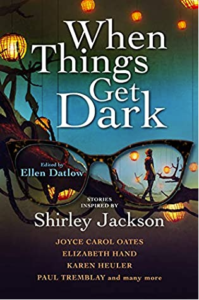I am genuinely impressed by the way this collection invokes the spirit of Shirley Jackson. So many of the stories read as if they might have come from her pen, so seamlessly do they fit into the dark atmosphere engendered by stories such as The Haunting Of Hill House, The Lottery and We Have Always Lived In The Castle. This is a book of repressed women with unspeakable secrets; of insular communities with murderous tendencies; of finding both oppression and release in the supernatural — all hallmarks of that master of quiet, furious dread.
 Despite that commonality, the eighteen stories here each stand as distinct entities. While the ones set in the past (or, as in Genevieve Valentine’s kaleidoscopic Sooner Or Later, Your Wife Will Drive Home, a number of eras) evoke more closely Ms Jackson’s mid-20th-century aesthetic, the modern tales feel like a natural carrying over of her work into the 21st century, where her themes are anything but alien. That said, perhaps my favorite story in this collection — for non-personal reasons anyway — is Tiptoe by Laird Barron, about a child of the 60s who tries to grapple with the family secrets that continue to haunt him decades later. One of the most overtly supernatural and creepy offerings here, the image of adult Greg playing the “game” will stay indelibly in my mind.
Despite that commonality, the eighteen stories here each stand as distinct entities. While the ones set in the past (or, as in Genevieve Valentine’s kaleidoscopic Sooner Or Later, Your Wife Will Drive Home, a number of eras) evoke more closely Ms Jackson’s mid-20th-century aesthetic, the modern tales feel like a natural carrying over of her work into the 21st century, where her themes are anything but alien. That said, perhaps my favorite story in this collection — for non-personal reasons anyway — is Tiptoe by Laird Barron, about a child of the 60s who tries to grapple with the family secrets that continue to haunt him decades later. One of the most overtly supernatural and creepy offerings here, the image of adult Greg playing the “game” will stay indelibly in my mind.
My personal personal favorite was Gemma Files’ Pear Of Anguish. Idk if it’s adolescent girls especially who are susceptible to the building of these reality-bending paracosms — or if it’s just that those of us who built them are more open about fictionalizing or even discussing them as adults than our counterparts of other genders — but I felt the strange, destructive relationship between Imogen and Una in my bones. I also really enjoyed the many stories within the story that is Kelly Link’s Skinder’s Veil, almost more than the whole itself, which I felt was somewhat let down by its ending: more’s the pity as this is the story that also completes the book.
Elizabeth Hand’s For Sale By Owner, in contrast, had a very strong ending, even if I really did want to know more about what Rose saw. The ending of Stephen Graham Jones’ Refinery Road was also strong, capping a very satisfying entry: similarly with the almost cheerful resignation that closes Richard Kadrey’s A Trip To Paris. Carmen Maria Machado’s beautifully constructed A Hundred Miles And A Mile also had the benefit of feeling like a close homage to a famous episode from Eleanor’s drive to Hill House. I wonder whether reading more of Ms Jackson’s oeuvre would have helped me spot other subtle influences in the rest of the stories here. But even my passing knowledge of her work impressed on me not only how she could inspire an entire aesthetic, but also how deeply influential she continues to be in the horror, speculative fiction and psychological thriller genres.
Kudos as always must go to Ellen Datlow for not only thinking to do an anthology based on Ms Jackson’s work, but also for doing such an excellent job curating it. Nearly all the stories are outstanding: I’m sure I would only appreciate them further were I more familiar with the rest of Ms Jackson’s bibliography.
When Things Get Dark edited by Ellen Datlow was published September 21 2021 by Titan Books and is available from all good booksellers, including
